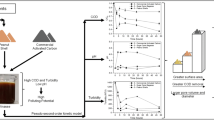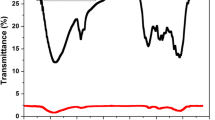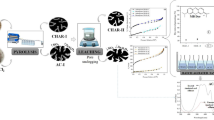Abstract
Studies on the removal of polyphenols from sugarcane vinasses using three upflow anaerobic sludge blanket (UASB) reactors operating isothermally at temperatures of 45, 55, and 65 °C are presented. The procedure started evaluating the stability of the reactors through the quantification of four important parameters of the process: temperature, pH, alkalinity factor, and acetic acid production. The physical and chemical characterizations of the vinasses were made to evaluate the applied treatment. Total polyphenols were quantified before and after the biochemical treatment using the Folin-Ciocalteu’s method. The obtained results showed that this biochemical treatment was not enough by itself to remove the phenolic compounds present in the vinasses feed. The use of complementary treatment for the removal of polyphenols with activated carbon was proposed and evaluated. The effectiveness of the adsorption process was analyzed and compared through the models of Langmuir, Freundlich, and Dubinin-Radushkevich, using the obtained experimental data. The model that provided the best fit of the experimental data was the Langmuir model with a correlation coefficient of 0.991. The adsorption process achieved to reduce the concentration of polyphenols in the vinasses from 3600 mg of gallic acid equivalent (GAE)/L to 1072 mg GAE/L by single-step adsorption. That is equivalent to an overall reduction of 70.2%.




Similar content being viewed by others
Data Availability
Data are available upon request.
Change history
20 August 2020
The original version of this article unfortunately contained an error.
Abbreviations
- ANOVA:
-
analysis of variance
- BOD5 :
-
biochemical oxygen demand at 5 days (mg/L)
- COD:
-
total chemical oxygen demand (mg/L)
- DV:
-
reactor influent 50:50 tap water diluted vinasses
- DV65:
-
reactor influent 75:25 tap water diluted vinasses
- GAE:
-
gallic acid equivalent
- GC-FID:
-
gas chromatograph with a flame ionization detector
- R:
-
reactor
- R 2 :
-
correlation coefficient, coefficient of determination, or coefficient of multiple determination for multiple regression statistical measure of how close the data are to the fitted regression line
- SV:
-
Sugarcane-ethanol industry vinasses
- UASB reactor:
-
Upflow anaerobic sludge blanket reactor
- 45°C-R:
-
Reactor operating at 45 °C
- 55°C-R:
-
Reactor operating at 55 °C
- 65°C-R:
-
Reactor operating at 65 °C
- B :
-
Dubinin-Radushkevich constant (mg2/J2)
- C :
-
equilibrium concentration (mg/L)
- K :
-
Langmuir adsorption constant (mg/L)
- K a :
-
thermodynamic equilibrium constant, adimensional
- K F :
-
Freundlich constant (mg/g)
- n :
-
adjustment parameter, adimensional
- p :
-
p value or probability value is the probability of obtaining test results at least as extreme as the results observed during the test, assuming that the null hypothesis is correct (Aschwanden 2019)
- q :
-
efficiency of adsorption (mg/g)
- q o :
-
Langmuir empirical constant (mg/g)
- q m :
-
theoretical isotherm saturation capacity (mg/g)
- R :
-
universal gas constant (J/mol K)
- T :
-
absolute temperature (K)
- α :
-
alkalinity factor
- ∆G :
-
change in the Gibbs free energy (kJ/mol)
- Ɛ :
-
Dubinin-Radushkevich isotherm constant (J/g)
References
Adebooye, O. C., Alashi, A. M., & Aluko, R. E. (2018). A brief review on emerging trends in global polyphenol research. Journal of Food Biochemistry, 42(4), 1–7. https://doi.org/10.1111/jfbc.12519.
APHA. (2012). Standard methods for the examination of water and wastewater. Washington DC: American Public Health Association.
Arimi, M. M., Zhang, Y., Götz, G., Kiriamiti, K., & Geißen, S. U. (2014). Antimicrobial colorants in molasses distillery wastewater and their removal technologies. International Biodeterioration & Biodegradation, 87(1), 34–43. https://doi.org/10.1016/j.ibiod.2013.11.002.
Aschwanden, C. (2019). Not even scientists can easily explain p-values. FiveThirtyEight. Archived from the original on 25 September 2019. https://fivethirtyeight.com/features/not-even-scientists-can-easily-explain-p-values/. Accessed 11 Oct 2019
Bailey, J. E., & Ollis, D. F. (1986). Biochemical engineering fundamentals. New York: McGraw Hill chemical engineering series, ISBN-10: 0070032122, ISBN-13: 978-0070032125.
Barros, V. G. D., Duda, R. M., & Oliveira, R. A. D. (2016). Biomethane production from vinasse in upflow anaerobic sludge blanket reactors inoculated with granular sludge. Brazilian Journal of Microbiology, 47(3), 628–639. https://doi.org/10.1016/j.bjm.2016.04.021.
Bautista-Zúñiga, F., Durán-de-Bazúa, C., Reyna-Trujillo, T., & Villers-Ruiz, L. (2000a). Agroindustrial organic residues: Handling options in canesugar processing plants. Sugar y Azúcar, 95(9):32-45 (in English). Residuos orgánicos agroindustriales: Opciones de manejo en los ingenios azucareros. Sugar y Azúcar, 95(10):23-37 (2000) (in Spanish). ISSN: 0039-4742. Accessed in paper version in 2010.
Bautista-Zúñiga, F., Durán-de-Bazúa, C., & Lozano, R. (2000b). Cambios químicos en el suelo por aplicación de materia orgánica soluble tipo vinazas. Revista Internacional de Contaminación Ambiental. 16(3), 89–101 (in Spanish). ISSN 0188-4999. https://www.revistascca.unam.mx/rica/index.php/rica/article/view/32547.
Bautista-Zúñiga, F., & Durán-de-Bazúa, C. (1998). Análisis del beneficio y riesgo potenciales de la aplicación al suelo de vinazas crudas y tratadas biológicamente. Revista Internacional de Contaminación Ambiental. 14(1), 13–19 (in Spanish). ISSN 0188-4999. https://www.revistascca.unam.mx/rica/index.php/rica/article/view/32919.
Bautista-Zúñiga, F., Rivas, H., Durán-de-Bazúa, C., & Palacio, G. (1998). Caracterización y clasificación de suelos con fines productivos en Córdoba, Veracruz, México. Investigaciones Geográficas Boletín, 36, 21–33 (in Spanish), ISSN: 0188-4611, e-ISSN: 2448-7279. http://www.scielo.org.mx/scielo.php?script=sci_arttext&pid=S0188-46111998000200003. Accessed in paper version in 2010.
Bernal-González, M., Vergara-Salgado, S., & Durán-Domínguez-de-Bazúa, C. (2012). Identification of methanogenic and sulfato-reducing bacteria from three upflow anaerobic sludge blanket reactors operating at 45, 55, and 65°C with sugarcane-based vinasses diluted with tap water (50:50). Journal of Microbial and Biochemical Technology, 4(5), 111–120.
Bernal-González, M., Toscano-Pérez, D., Falcón, L. I., Alcántara-Hernández, R. J., Salgado-Bernal, I., Solís-Fuentes, J. A., & Durán-Domínguez-de-Bazúa, M. d. C. (2016). Archaea, a useful group for unconventional energy production: methane production from sugarcane secondary distillation effluents using thermotolerant strains. In VK Gupta, National University of Ireland Galway, Ireland, GD Sharma, Bilaspur University, India, MG Tuohy, National University of Ireland Galway, Ireland, R Gaur, RML Avadh University, India, editors. The handbook of microbial bioresources. CABI. ISBN 9781780645216. Chapter 32. Pp. 502–527. Oxfordshire, United Kingdom. https://doi.org/10.1079/9781780645216.0502
Bucio-Noble, D., Kautto, L., Krisp, C., Ball, M. S., & Molloy, M. P. (2018). Polyphenol extracts from dried sugarcane inhibit inflammatory mediators in an in vitro colon cancer model. Journal of Proteomics, 177, 1–10. https://doi.org/10.1016/j.jprot.2018.02.009.
Caqueret, V., Cagnon, B., Bostyn, S., & Fauduet, H. (2012). Removal of dark coloured and polyphenolic compounds of sugar beet vinasse by adsorption onto activated carbons: application to a crosscurrent adsorption process. The Canadian Journal of Chemical Engineering, 90(2), 403–411. https://doi.org/10.1002/cjce.20550.
Caqueret, V., Bostyn, S., Cagnon, B., Fauduet, H. 2008. Purification of sugar beet vinasse-adsorption of polyphenolic and dark colored compounds on different commercial activated carbons. Bioresource Technology. 99(13):5814-5821.
Castro-González, A., & Durán-de-Bazúa, C. (2001). Adaptation of anaerobic biomass to a new substrate in an anaerobic sludge bed reactor. Tecnología Ciencia y Educación (IMIQ México), 16(1), 49–55 (in Spanish).
Cavinato, C. (2011). Anaerobic digestion fundamentals. I. Summer school on biogas technology for sustainable second-generation biofuel production. www.valorgas.soton.ac.uk/Pub_docs/JyU%20SS%202011/CC%201.pdf Accessed 29 Oct 2018.
Cruz-Salomón, A., Meza-Gordillo, R., Rosales-Quintero, A., Ventura-Canseco, C., Lagunas-Rivera, S., & Carrasco-Cervantes, J. (2017). Biogas production from a native beverage vinasse using a modified UASB bioreactor. Fuel, 198, 170–174. https://doi.org/10.1016/j.fuel.2016.11.046.
Dada, A. O., Olalekan, A. P., Olatunya, A. M., & Dada, O. (2012). Langmuir, Freundlich, Temkin and Dubinin-Radushkevich isotherms studies of equilibrium sorption of Zn2+ unto phosphoric acid modified rice husk. IOSR Journal of Applied Chemistry, 3(1), 38–45. https://doi.org/10.9790/5736-0313845.
Díaz, B., Gomes, A., Freitas, M., Fernandes, E., Nogueira, D., González, J., Moure, A., Levoso, A., Vinardell, M., Mitjans, M., Domínguez, H., & Parajó, J. (2012). Valuable polyphenolic antioxidants from wine vinasses. Food and Bioprocess Technology, 5(7), 2708–2716. https://doi.org/10.1007/s11947-011-0569-8.
Durán-de-Bazúa, C., Cabrero, M. A., & Poggi, H. M. (1991). Vinasses biological treatment by anaerobic and aerobic processes: laboratory pilot-plant tests. Bioresource Technology, 35(1), 87–93. https://doi.org/10.1016/0960-8524(91)90086-Y.
España-Gamboa, E., Mijangos-Cortes, J., Barahona-Perez, L., Dominguez-Maldonado, J., Hernández-Zarate, G., & Alzate-Gaviria, L. (2011). Vinasses: characterization and treatments. Waste Management & Research, 29(12), 1235–1250. https://doi.org/10.1177/0734242X10387313.
España-Gamboa, E. I., Mijangos-Cortés, J. O., Hernández-Zárate, G., Maldonado, J. A. D., & Alzate-Gaviria, L. M. (2012). Methane production by treating vinasses from hydrous ethanol using a modified UASB reactor. Biotechnology for Biofuels, 5(82), 1–9. https://doi.org/10.1186/1754-6834-5-82.
FAO (2011) Manual de biogás. Global Environment Facility. https://www.minenergia.cl/biogaslechero/wp-content/uploads/2015/12/as400s.pdf. Acceded 17 Apr 2017.
Fernandes, J. M., Sousa, R. M. O., Fraga, I., Sampaio, A., Amaral, C., Bezerra, R. M., & Dias, A. A. (2019). Fungal biodegradation and multi-level toxicity assessment of vinasse from distillation of winemaking by-products. Chemosphere, 238(2020), 1–8. https://doi.org/10.1016/j.chemosphere.2019.124572.
Foo, K. Y., Lee, L. K., & Hameed, B. H. (2013). Preparation of activated carbon from sugarcane bagasse by microwave assisted activation for the remediation of semi-aerobic landfill leachate. Bioresource Technology, 134, 166–172. https://doi.org/10.1016/j.biortech.2013.01.139.
Geankoplis, C. J. (2003). Transport processes and separation process principles: (includes unit operations). Englewood Cliffs: Prentice Hall.
Hussein, H. S., & Brasel, J. M. (2001). Toxicity, metabolism, and impact of mycotoxins on humans and animals. Toxicology, 167(2), 101–134. https://doi.org/10.1016/S0300-483X(01)00471-1.
Kaushik, A., Basu, S., Singh, K., Batra, V. S., & Balakrishnan, M. (2017). Activated carbon from sugarcane bagasse ash for melanoidins recovery. Journal of Environmental Management, 200, 29–34. https://doi.org/10.1016/j.jenvman.2017.05.060.
Knoll, G., & Winter, J. (1987). Anaerobic degradation of phenol in sewage sludge. Applied Microbiology and Biotechnology, 25(4), 384–391. https://doi.org/10.1007/BF00252552.
Liang, X.-Q., Fan, S.-L., Zhang, J.-X., & Song, X.-R. (2019). Polyphenol removal from sugarcane juice by using magnetic chitosan composite microparticles. Sugar Tech, 21(1):104-112. https://doi.org/10.1007/s12355-018-0625-z.
Liu, D., Lopez-Sanchez, P., Martinez-Sanz, M., Gilbert, E. P., & Gidley, M. J. (2019). Adsorption isotherm studies on the interaction between polyphenols and apple cell walls: effects of variety, heating and drying. Food Chemistry, 282, 58–66. https://doi.org/10.1016/j.foodchem.2018.12.098.
López, I., Borzacconi, L., & Passeggi, M. (2018). Anaerobic treatment of sugar cane vinasse: treatability and real-scale operation. Journal of Chemical Technology & Biotechnology, 93(5), 1320–1327. https://doi.org/10.1002/jctb.5493.
López-López, A., León-Becerril, E., Rosales-Contreras, M. E., & Villegas-García, E. (2015). Influence of alkalinity and VFAs on the performance of an UASB reactor with recirculation for the treatment of tequila vinasses. Environmental Technology, 36(19), 2468–2476. https://doi.org/10.1080/09593330.2015.1034790.
Marsal, A., Maldonado, F., Cuadros, S., Bautista, M. E., & Manich, A. M. (2012). Adsorption isotherm, thermodynamic and kinetics studies of polyphenols onto tannery shavings. Chemical Engineering Journal, 183, 21–29. https://doi.org/10.1016/j.cej.2011.12.012.
Manahan, S. E., Larsen, D. R., Durán-Moreno, A., & Durán-de-Bazúa, C. (2000). La gasificación como una opción para la disposición de residuos peligrosos. Rev. IMIQ (Méx), 41(1–2), 35–39 (in Spanish). ISSN 0188-7319.
Manahan, S. E., Enríquez-Poy, M., Molina, L. T., & Durán-de-Bazúa, C. (2007). Energy and activated carbon production from crop biomass byproducts. In J. Klapp, J. L. Cervantes-Cota, J. F. Chávez-Alcalá. Towards a cleaner planet. Energy for the future. Eds. ISBN 10 3-540-71344-1, 13 978-3-540-71344-9. ISSN 1863-5520. Berlin, Heidelberg, New York: Springer Verlag. Pp. 365-387.
Muñoz-Bernal, Ó. A., Torres-Aguirre, G. A., Núñez-Gastélum, J. A., de la Rosa, L. A., Rodrigo-García, J., Ayala-Zavala, J. F., & Álvarez-Parrilla, E. (2017). New approach to the interaction of the Folin-Ciocalteu reagent with sugars during the quantification of total polyphenols. TIP Specialized Magazine in Biological and Chemical Sciences, 20(2), 23–28 (in Spanish). https://doi.org/10.1016/j.recqb.2017.04.003.
Padilla-Gasca, E., López-López, A., & Gallardo-Valdez, J. (2011). Evaluation of stability factors in the anaerobic treatment of slaughterhouse wastewater. Journal of Bioremediation & Biodegradation, 2(1), 1000114 https://www.omicsonline.org/evaluation-of-stability-factors-in-the-anaerobic-treatment-of-slaughterhouse-wastewater-2155-6199.1000114.pdf Accessed 29 Oct 2018.
Parsaer, M., Kiani, M. K. D., & Karimi, K. (2019). A review of biogas production from sugarcane vinasse. Biomass and Bioenergy, 122, 117–125. https://doi.org/10.1016/j.biombioe.2019.01.034.
Rosille-Callé, F., Bajay, S. V., & Rothman, H. (2000). Industrial uses of biomass energy: the example of Brazil. London and New York: Taylor and Francis.
Rincón-Acelas, I. R. (2008). Kinetics of thermophilic anaerobic degradation of cane vinasse. Master’s Thesis. UNAM. Mexico City, Mexico (in Spanish). http://132.248.9.195/ptd2008/septiembre/0632214/Index.html Accessed 10 Dec 2018.
Sankaran, S., Khanal, S. K., Jasti, N., Jin, B., Pometto III, A. L., & Van Leeuwen, J. H. (2010). Use of filamentous fungi for wastewater treatment and production of high value fungal byproducts: a review. Critical Reviews in Environmental Science and Technology, 40(5), 400–449. https://doi.org/10.1080/10643380802278943.
Solís-Fuentes, J. A., Hernández-Ceja, Y., Hernández-Medel, M. d. R., García-Gómez, R. S., Bernal-González, M., Mendoza-Pérez, S., & Durán-Domínguez-de-Bazúa, M. d. C. (2019). Quality improvement of jaggery, a traditional sweetener, using bagasse activated carbon. Journal of Food Bioscience., 32, 100444. https://doi.org/10.1016/j.fbio.2019.100444.
Suhaili, N., Cárdenas-Fernández, M., Ward, J. M., & Lye, G. J. (2019). Potential of sugar beet vinasse as a feedstock for biocatalyst production within an integrated biorefinery context. Journal of Chemical Technology & Biotechnology, 94(3), 739–751. https://doi.org/10.1002/jctb.5819.
Sun, Q., Chen, B., Li, Y., Yuan, G., Xu, Z., Guo, X., & Yang, L. (2019). Enhanced separation of coal bed methane via bioclathrates formation. Fuel, 243, 10–14. https://doi.org/10.1016/j.fuel.2019.01.045.
Tsai, W. T., Chang, C. Y., Lin, M. C., Chien, S. F., Sun, H. F., & Hsieh, M. F. (2001). Adsorption of acid dye onto activated carbons prepared from agricultural waste bagasse by ZnCl2 activation. Chemosphere, 45(1), 51–58. https://doi.org/10.1016/s0045-6535(01)00016-9.
Utami, I., Redjeki, S., & Astuti, D. H. (2016). Biogas production and removal COD-BOD and TSS from wastewater industrial alcohol (vinasse) by a modified UASB bioreactor. In MATEC Web of Conferences, 58, 1–5. https://doi.org/10.1051/matecconf/20165801005.
Waterhouse, A. L. (2002). Determination of total phenolics. Current protocols in food analytical. Chemistry, 6, 11.11–11.18. https://doi.org/10.1002/0471142913.fai0101s06.
Wilkie, A. C., Riedesel, K. J., & Owens, J. M. (2000). Stillage characterization and anaerobic treatment of ethanol stillage from conventional and cellulosic feedstocks. Biomass and Bioenergy, 19(2), 63–102. https://doi.org/10.1016/S0961-9534(00)00017-9.
Yangui, A., & Abderrabba, M. (2018). Towards a high yield recovery of polyphenols from olive mill wastewater on activated carbon coated with milk proteins: experimental design and antioxidant activity. Food Chemistry, 262, 102–109. https://doi.org/10.1016/j.foodchem.2018.04.091.
Acknowledgments
Vinasses were provided by a Mexican cooperating sugarcane by-product distillery.
Funding
Funding was provided by the Universidad Nacional Autónoma de México, UNAM (in Spanish). First author received a graduate study scholarship granted by the Mexican Consejo Nacional de Ciencia y Tecnología, Conacyt (Mexican National Council for Science and Technology (Consejo Nacional de Ciencia y Tecnología, Conacyt, in Spanish). Reagents, glassware, and consumable materials were obtained with the projects PAPIME (PE100514) (Programa de Apoyo a la Investigación y Mejoramiento de la Enseñanza, in Spanish), PAPIIT (IN-118111-2) (Programa de Apoyo a Proyectos de Investigación e Innovación Tecnológica, in Spanish), and PAIP (5000-9067) (Programa de Apoyo a la Investigación y el Posgrado in Spanish); all of them are from UNAM (Universidad Nacional Autónoma de México, in Spanish). The main results of this paper were presented as a poster at 6ISEBE with the financial support of the UNAM Graduate Program of Chemical Sciences and the Conacyt PAEP (Program for Supporting Graduate Studies in Spanish).
Author information
Authors and Affiliations
Corresponding author
Ethics declarations
Competing Interests
The authors declare that there are no competing interests.
Code Availability
Not applicable.
Additional information
Publisher’s Note
Springer Nature remains neutral with regard to jurisdictional claims in published maps and institutional affiliations.
Rights and permissions
About this article
Cite this article
Contreras-Contreras, J.A., Bernal-González, M., Solís-Fuentes, J.A. et al. Polyphenols from Sugarcane Vinasses, Quantification, and Removal Using Activated Carbon After Biochemical Treatment in Laboratory-Scale Thermophilic Upflow Anaerobic Sludge Blanket Reactors. Water Air Soil Pollut 231, 401 (2020). https://doi.org/10.1007/s11270-020-04733-5
Received:
Accepted:
Published:
DOI: https://doi.org/10.1007/s11270-020-04733-5




